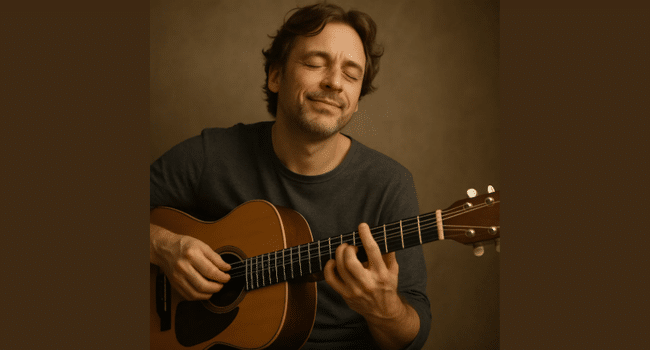Table of Contents
When someone buys an instrument at Everest Music, they each come with a different goal: a hobby, an upgrade, a desire to try something new, or simply a distraction. And a lot of these reasons boil down to one thing—fighting stress. Over the past 40+ years of running this store, we’ve seen countless stories of how music has changed people’s lives.
So we want to share how we believe playing musical instruments helps with emotional recovery—even if you don’t yet know how to play.
Inner Balance, Stress Relief, and the Power of Musical Instruments
Music therapy can guide you toward inner balance. Singing or playing even simple instruments helps people release tension, give voice to things they can’t put into words, and helps to clear the mind.
Music provides a non-verbal outlet for personal and important emotions. It eases anxiety and helps with panic and fear. It also boosts self-esteem as a person does something they’ve never done before… and succeeds.
There’s something about drumming that lets people release all their pent-up emotions.
The mental health benefits of music:
- It unlocks creative potential, which supports emotional stability
- It builds imagination and resilience, helping to manage stress and strengthen the nervous system
- In music therapy, people feel like soloists or ensemble members
- Through play, people learn basic public speaking skills and overcome shyness
- It trains the freedom of self-expression
Music Therapy: What Science Says
Music therapy is a gentle and environmentally friendly method of psychological work, in which a person allows themselves to express their strongest emotions, discuss the most frightening topics, and be heard and accepted. All of this happens with a minimum of words and a maximum of sound.
Music therapy is used in various institutions such as rehabilitation centers, psychiatric hospitals, maternity hospitals, palliative care centers, educational institutions at different levels, and social services. It is naturally one of the tools of psychotherapeutic work. Music therapy has been shown to be very helpful for a wide range of mental health problems, including mental disorders, neurological conditions, psychosomatic symptoms, and overcoming the effects of PTSD
Skills Development
Playing a musical instrument today is more than just learning songs. It’s like learning a language—it opens the door to new ways of communicating. Mastering a musical instrument enhances:
- hearing, attention, and fine motor skills;
- improves cultural understanding;
- develops neural connections;
- benefits psychological health.
Let’s dive deeper.
Communication
Even at the beginner level, music teaches:
- How to collaborate and coordinate with others
- How to focus on your part while staying aware of your teacher and fellow musicians
- How to divide one’s attention into two streams
Creativity & Decision-Making
Improvisation teaches you to think outside the box, adapt, make quick decisions, and reuse knowledge in new ways.
Intelligence & Logic
Instruments like the guitar or the ukulele help build:
- Interval recognition and harmonic understanding
- Chord sequences and complex piece memorization
Musicians master the art of improvisation, compare rhythmic patterns, and compose their own melodies. Each composition has a certain logic that helps to connect musical segments into a single whole.
How does this affect brain activity? The left hemisphere is responsible for rhythm, and the right hemisphere helps to hear the timbre of the melody. It has been established that playing the instrument develops both hemispheres, so the guitarist uses them simultaneously.
Musical Instruments and Brain Aging
Learning to play an instrument can help protect the brain from aging. Instruments like the piano and guitar are linked to improved memory and executive function. Singing also shows cognitive benefits.
Music is a way to build what scientists call “cognitive reserve”—the brain’s ability to adapt, stay sharp, and bounce back.
How To Start Playing an Instrument
Whatever instrument you choose, it’s important that you enjoy it. That’s it. Not what your friend plays. Not what seems “easy” or “practical.” If you don’t like the piano, try the guitar. If you don’t like stringed instruments, try the clarinet.
Step 1: Before anything else—before scales or chords or even thinking about “learning”—just explore. Sit with the instrument. Touch the strings or keys, pluck a note or two, try to copy a melody you know by ear. You’re just getting comfortable. That’s more important than you think.
Step 2: Once you’re feeling a bit more confident holding your instrument, learn the very basics. A couple of chords. Maybe how rhythm works. Some simple finger movements. That’s enough to get you started. We always say, Learn a little, then play a lot. Don’t get stuck in theory—it should help you, not overwhelm you.
Step 3: You don’t need to practice for hours. Honestly, 15 to 30 minutes a day is perfect. We’ve seen students get farther doing a little each day than others who try to cram once a week.
Set small, fun goals. Like “learn one easy tune this week” or “switch between two chords without looking.” Celebrate the small wins.
These days, there are loads of free tutorials on YouTube, great apps, and online courses—some free, some paid. Don’t be afraid to ask experienced musicians and teachers for help. Sometimes, just one lesson with a good teacher can save you weeks of frustration.
Final Thoughts
The language of music is universal. It’s our biological language. Through music, people can express different emotional states or certain things that are very difficult to express in words.
That’s why I always remind people: rhythm lives in all of us. Each of us has a heartbeat in a certain rhythm. If you walk, you have rhythm. If you speak with emotion, you already use musical intonation.
There’s no reason to be afraid of music. I used to tell my students: You can write something beautiful with just three notes. You don’t need an orchestra. What matters is having something to say.
